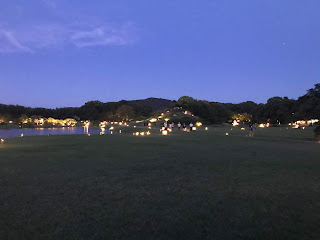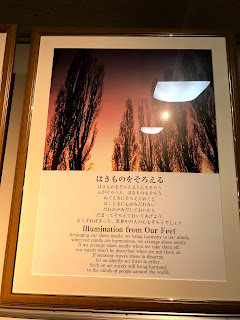Cute Japan
Let me share with you the places of interest I so much enjoyed. Many of them are what I showed to my guests while working as an English-speaking tour guide with national license. Also try my former site (http://blog.goo.ne.jp/jasmine-rosemary) or find me on facebook (jasmine nakai).
Friday, August 24, 2018
scenic miyajima from the sea
A local oyster farming business offers a boat ride to the oyster beds and near miyajima. The symbolic tori gate is seen, behind which the fabulous shinto shrine, Itsukushima Jinja, stands.
The sea is so close and that gives you a different view and feeling.
an ancient tower stands still in Yamaguchi
Known to be one of the three most beautiful five-roofed pagodas in Japan, this Buddhist tower stands quietly. A Haiku poem inscribed on a slab of rock on the premises of Ruriko-ji temple in Yamaguchi city says,
early summer
An old temple nestled in hills
A traveler stands still at an ancient tower
evening garden
Korakuen garden once in a while is open in the evening. Recommended you go there a little after 6:00 pm and see how the sky changes its colors.
Monday, August 6, 2018
hakusan heisenji is my real favorite
 |
| moss-covered Heisenji in Katsuyama, Fukui |
 |
| to the worshipping hall; behind stands the main hall |
 |
| moss and criptomeria threes |
 |
| These two trees are actually one. A branch that drooped down to the ground due to heavy snow got rooted and the new trunk grew from there. |
Some memorable posters at Eiheiji zen temple
Heisenji premises are very large. An excellent local volunteer guide took us around for 2 hours and a half as I asked in advance. We could have spent another hour but should have still missed the excavation site.
My friend and I spent the happiest 2.5 hours. The moss was completely beautiful, green-carpeting the grounds. The history was felt, both glorious and devastating. Not like temples and shrines known to everybody and always crowded with tourists, the temple showed real Japan where indigenous faith named Shinto after Buddhism got to Japan and those introduced from abroad mainly Buddhism found a way to evolve together.
Above all, it is believed that in this place started the worship of Hakusan mountain.
Nearby stands the great zen temple. Well-known as Soto zen sect headquarters and monastery, the temple accepts some 70 young monks in training every year. They come, stay for a few years on average, and then leave. The temple regularly shelters around 150 monks including the trainees. You too can stay there overnight and experience a bit of zen.
But I have to say that my real favorite is Heisen-ji.
Sunday, August 5, 2018
the hill of the Buddha, Makomanai, Sapporo
Renovated by ANDO Tadao. A large cemetery that became attractive thanks to renovation completed a few years ago. Once the Buddha statue sat alone and not effectively focused. Now people pay attention to him and the air surrounding him makes him holly.
The whole place embodies Hokkaido; the scale is suitable for the large open land in the north of Japan.

Nearby is the outdoor art museum; a great number of sculptures. My favorite was, after all, YASUDA Kan's piece.
The whole place embodies Hokkaido; the scale is suitable for the large open land in the north of Japan.

Nearby is the outdoor art museum; a great number of sculptures. My favorite was, after all, YASUDA Kan's piece.
 |
| by YASUDA Kan, a Hokkaido-born artist |
Nizayama Forest Art Museum
 |
| artwork at the approach |
 |
| entrance |
 |
| special exhibit |
 |
| inside artwork |
 |
| legacy from the power plant days |
 |
| on the hill behind the museum |
 |
| museum seen from the hill |
 |
| scenery around the museum |
Tucked in a small community where the sky is large, this unique power station-turned art museum was built thanks to the passion of the then town mayor. The town did not have any art museums and the mayor thought it was a pity. The Hokuriku Power Company kindly donated the defunct power station building after the new one was built and when the original one was about to be dismantled.
Three times a year, the museum holds special exhibitions and during these periods only, you are admitted into the museum.
This time, finally, I managed to come with a younger friend of mine who have often been with my past explorations.
The art by Florian Claar was fantastic; the museum building felt history; and above all we were part of the GHIBLI outlook of the world. We saw the sprawling rice field and thought of where we came from and where we go.
Saturday, August 4, 2018
TAD blends in with the park environment
Fully open last year in 2017, the TAD or Toyama Museum of Art and Design is a fantastic place for locals and for visitors alike.
It was built as part of a comprehensive urban development project and almost part of the Kansui Park, which means the park of water in cycles.
The former canal which lost its original objective of transportation was on the verge of being dismantled but someone who saw the real significance of the canal (amazingly a government official who was knowledgeable of canals and had been fascinated by how they could be used for enhancing the community life style) advised the city to stop it. Locals had to discuss the matter and had to be far-sighted. Then the city of Toyama finally decided on the very wise development project. The locals must be very proud of their decision now.
The Starbucks known to be at the most scenic place stands on the premises of the park, overlooking the canal. People hang out on the outside deck. The sunset seen from there is said to be fantastic.
 |
| to the museum |
 |
| to the rooftop |
 |
| rooftop playground |
 |
| Kansui Park seen from the rooftop |
 |
| special exhibition of SENJU Hiroshi was held |
 |
| artistic white bear |
Wednesday, July 25, 2018
noodle for okonomiyaki
Isono Seimen noodle factory is providing its noodle to many okonomiyaki restaurants. They also run an okonomiyaki restaurant themselves. The first floor of the building is the factory and the second floor is a restaurant. Nearby run JR trains and the baseball stadium, the home ground for Hiroshima Carp, stands across the railways.
Here's the factory.
Here's the factory.
Saturday, June 23, 2018
SENJU Hiroshi Museum of Art in Karuizawa
Karuizawa itself is a good summer resort with crisp air and within an easy access from Tokyo.
But I went there only for the sake of this museum. Stunning artworks and incredible architecture are combined and the place was simply enchanting.
The linked videos show you who Senju is and how his museum designed by genius NISIZAWA Ryue looks.
And here's the entrance to his art museum in Naka-karuizawa, Nagano.
But I went there only for the sake of this museum. Stunning artworks and incredible architecture are combined and the place was simply enchanting.
The linked videos show you who Senju is and how his museum designed by genius NISIZAWA Ryue looks.
And here's the entrance to his art museum in Naka-karuizawa, Nagano.
Saturday, June 2, 2018
perhaps better to keep the bunny island off-the-beaten path
 |
| bunnies at the former power station built in 1929 along with the poison gas factory complex. |
Having said that, however, bunnies were hard to ignore. Anytime, at any visit, they were so cute.
Soon the transformation of the Tadanoumi Port began because of the bunny movies on the net. The port didn't have any back then except the free parking lot which I really appreciated. Now the ticket selling complex sells touristy bunny souvenirs. The Smart Exchange system will be helpful for the overseas visitors. This is amazing to see at this small port.
 |
| pretty but not exactly my cup-of-tea |
 |
| catering to many currencies |
Going to the island on the weekend is what you would like to avoid if possible. Too many humans and too much food for the bunnies. At the end of the day, humans abandon the leftover veggies for the bunnies around the island port area. They could be eaten by bunnies later but the wild bores are happily eating them, too.
The island is not readily accessible but now I think it will be better that way to stop the surging impact by too many visitors on the island.
Humans have a tendency to cause trouble wherever they go. So let us look back at our footprints. If they are biodegradable and do not disturb the balance of ecosystem, the world would remain pristine.
 |
| pristine like this - but remember the past contamination |
TODAY'S STAR from the bunny island on June 1, 2018.
 |
| shina-chan aged five |
Shina-chan whose grandfather was abandoned in the island by his human owners, survived, thrived, and now his granddaughter is a very popular star!! Native bunnies on the island are brown but you often see so called "panda bunnies." They were former pets of the humans who left them on the island. A great number of humans are coming to the island particularly on the weekend. And of course they would like to feed the bunnies but too many humans bring in too much food and it has been causing trouble in some ways. The Takehara city authorities, please be wise and do not just pursue short-sighted exploitation. Pretty please from bunnies and do not forget the dark side of the history which has to be handed down as a lesson.
And more bunnies:
And peace cranes remembering the dead:
 |
| peace cranes to the former poison gas workers killed while working or later |
Friday, June 1, 2018
sagawa museum of fine arts has a remarkable tea ceremony room under the water
The highlight of the visit to this museum has to be a tour to the tea ceremony room, away from the totally secular surroundings of the museum. The tea ceremony room complex utilized light and shadow. This one was the most sensitive, most Japanese. Photography is not allowed during the tour. You just have to go there and imprint your memory.
Please visit the sagawa art museum web site to know more.
Please visit the sagawa art museum web site to know more.
Subscribe to:
Posts (Atom)


















